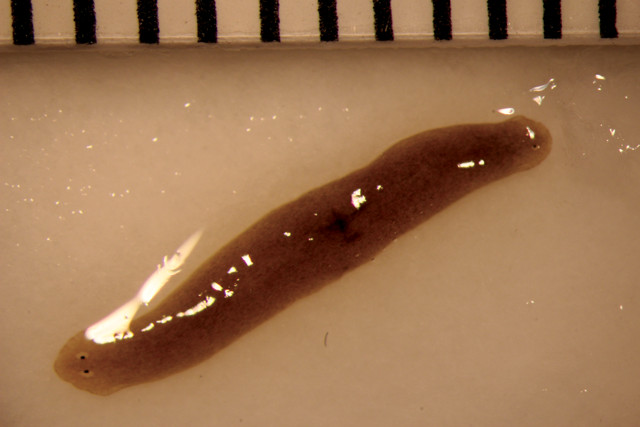
by Rachel Crowell Friday, October 13, 2017

An amputated flatworm fragment sent into space spontaneously regrew into an extremely rare double-headed worm. Credit: Junji Morokuma, Allen Discovery Center at Tufts University.
It sounds like the plot of a science fiction movie: Worms sent into space return to Earth with two heads. But it isn’t fiction at all. In a recent study, researchers sent worms with regenerative capabilities — some left whole and some cut into pieces — to the International Space Station (ISS) to study how the worms’ bodies would respond in space and whether their behavior might help efforts to treat human ailments.
The worms were all of the species Dugesia japonica, a type of planarian flatworm known to reproduce both sexually and asexually, and to regrow when split apart. Just before their launch to the ISS, some worms were cut into three segments each: heads, pharynxes (or midsections) and tails. During their five weeks in space, the flatworms left whole spontaneously fissioned, each worm dividing into multiple parts. The segments of both the pre-amputated and spontaneously fissioned flatworms then developed into new worms while in space.
Most of the regrown flatworms featured normal body structures, with each having a head, pharynx and tail. But one pre-amputated worm emerged as something of a scientific marvel. During regeneration, it grew two heads rather than a head and a tail. What’s more, even after this worm was back on Earth and the researchers re-amputated its heads, both regrew again. The scientists behind the study, published in the journal Regeneration, say they hope insights gained from the worm’s peculiar ability will help advance the fields of regenerative medicine and bioengineering.
Double-headed flatworms are “extremely rare,” both in cases where worms divide by spontaneous fission or are manually cut, the researchers wrote, adding that “the spontaneous occurrence of such a rare phenotype itself should be considered highly significant.” The team noted that in its laboratory, an estimated 15,000 “control worms” had been studied in the last five years “without a single double-headed animal arising from an untreated control fragment.”
Researchers demonstrated in previous studies that double-headed D. japonica can be induced in laboratories, says Michael Levin, a biologist at Tufts University and co-author of the recent study. In some studies, researchers temporarily induced this feature, Levin says, and in a previous study, he and his colleagues even showed that this double-headed characteristic can be permanently induced. After amputating a worm’s head and tail, the team used electricity to perturb the worm’s cellular communication, impairing the molecular mechanism that enables the worm’s body to sense when one head is already present, Levin says. As the worm regenerated its body parts, it was unable to recognize that a head already existed, so it grew a second head where the tail should have been. The worm’s genome wasn’t changed at all during this process, Levin notes.
In the new study, Levin and his colleagues report that they don’t know exactly what caused the one flatworm to spontaneously develop two heads. The space-traveling worms were subject to a variety of stresses, including microgravity, strong vibrations and g-forces. Determining the exact mechanism by which this flatworm regrew two heads, and whether it was caused by one factor or the “whole spaceflight experience,” will be the subject of future studies, Levin says — work that could lead to a better understanding of how space travel affects humans.
The study highlights the relevance of biological, electromagnetic and gravitational environments in shaping cellular and organismal architecture and functioning, says Mariano Bizzarri, a systems biologist at Sapienza University of Rome in Italy, who was not involved in the new study. “This implies that by changing the biophysical microenvironment, one could likely modify cell phenotype and behavior,” Bizzarri says, adding that the new work provides “a clear-cut demonstration that biophysical factors are critical in allowing living structures [to reach] a proper configuration.”
A major take-away from the study is that “the space travel experience alters the ability of cells to pattern themselves,” as well as the process of cellular decision-making that controls how cells function, Levin says. And if researchers can discover how pattern alterations occur and what’s behind cellular decision-making, they could potentially apply this knowledge in developing treatments for cancer or for regrowing missing or damaged organs in humans.
© 2008-2021. All rights reserved. Any copying, redistribution or retransmission of any of the contents of this service without the expressed written permission of the American Geosciences Institute is expressly prohibited. Click here for all copyright requests.